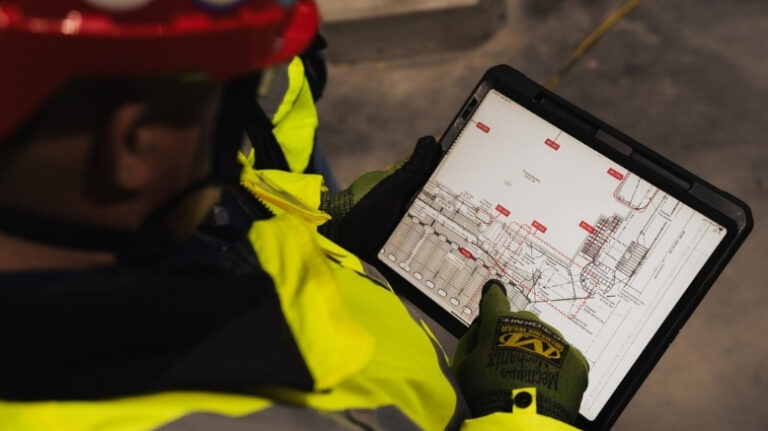— 10 min read
Project Visibility with Real-Time Dashboards: How Construction Teams Stay on Track


Last Updated Aug 22, 2025

Alex Six
Solution Specialist, C&I Industry Specialist
16 articles
Alex Six is an Enterprise & Strategic Civil & Infrastructure Overlay Account Executive for Procore. Alex has a long background in the construction industry beginning with an internship with one of the biggest contractors in the world, and expanding across projects with teams as small as 4 people and as large as multi-billion dollar budgets with large teams and disciplines. His resume includes Caltrans highways & bridges, Metro light rail & underground, as well as airport runways and utilities.

Taylor Riso
Contributing Writer
91 articles
Taylor Riso is a marketing professional with more than 10 years of experience in the construction industry. Skilled in content development and marketing strategies, she leverages her diverse experience to help professionals in the built environment. She currently resides in Portland, Oregon.
Last Updated Aug 22, 2025

Productivity in construction depends on more than just hitting daily targets in the field. It also requires quick decision-making and alignment between the office and the jobsite. Real-time dashboards centralize project data to give teams immediate visibility into what’s happening, where work is falling behind — and what needs attention ASAP.
For both civil and vertical contractors, adopting dashboards isn’t just a digital upgrade — it’s a shift in how projects are managed, coordinated and kept on schedule. In this article, we'll explore how these dashboards sharpen visibility, speed up decision-making and keep field and office teams in sync.
Table of contents
The Dual Nature of Productivity on the Jobsite
Staying productive on a jobsite takes more than keeping crews busy. It also depends on how efficiently the office supports the work — through approvals, documentation and coordination. Crews might be expected to pour 100 linear feet of curb in a day — but they can’t hit that target if submittals are late, RFIs are unresolved or permits haven’t come through.
Field and office teams operate on different timelines, but their success is tightly linked. Office-side processes like procurement, documentation and approvals have a direct impact on whether crews can stay on track. When any part of that workflow breaks down, the effects show up immediately on site: idle crews, delayed inspections or costly change orders.
It works in reverse, too. Without timely updates from the fielfd, office teams can’t move fast enough to keep the job progressing. Delays in sharing that information often snowball, turning minor hiccups into full-day disruptions.
If submittals are falling behind and turnaround times are slipping, that’s one of the earliest signs productivity is at risk.

Alex Six
Solution Specialist, C&I Industry Specialist
Procore Technologies
Common Signs That Productivity Is Slipping
Before major delays hit the schedule, smaller breakdowns in communication and planning often appear first. These early signals can be easy to miss — but catching them quickly can prevent costly downtime.
1. Submittals turnaround deadlines are stretched.
Most contracts require submittals to be returned within five to seven days. When turnaround times start stretching, it’s often a sign that design teams are falling behind or overloaded. That delay slows material procurement and risks pushing back important fieldwork.
2. 'Fire drills' become routine.
Missing equipment, delayed deliveries or misaligned crews force teams to reshuffle work on the fly. When these disruptions happen regularly, they signal deeper issues with planning, coordination or resource availability.
3. Field crews lack clear direction.
Crews showing up without the right construction drawings—or with no visibility into recent changes—often stall while waiting for clarification. Productivity drops when the field doesn’t have what it needs to execute the day’s work confidently.
4. Change orders or extra work go unprocessed.
Unresolved changes stack up fast. Without a formal change process to log, price and approve additional scope, teams either stop work or proceed without alignment — both of which create friction and rework later.
These issues may seem isolated, but they often signal that a project is losing momentum. Addressing them early is the best way to protect the schedule and keep crews on track.
What Real-Time Dashboards Actually Look Like
Real-time dashboards take the mess of fragmented emails, spreadsheets and handwritten notes and turn this information into a centralized, living snapshot of project health. For teams juggling thousands of moving parts, they offer a single source of truth to track what matters most.
What Dashboards Can Track
A typical dashboard pulls together data from across the project, often including:
- Open RFIs and submittals
- Safety observations or incidents
- Crew hours and labor costs
- Daily logs and work progress
- Committed cost vs. cost to complete
With all that information visible in one place, teams no longer need to chase down updates or guess whether an issue is being handled.
Why Real-time Matters
Before dashboards, most productivity issues surfaced during weekly or monthly cost meetings — sometimes long after the damage was done. With real-time data, changes are visible the moment they happen. Teams can catch errors, spot trends or address delays before they escalate.
How Dashboards Guide Decision-making
The value isn’t just in the data — it’s in the prioritization. Dashboards help surface what’s overdue, what’s at risk and what needs attention right now. Whether it's an RFI that’s holding up a pour or a submittal that's approaching its due date, the system flags it clearly so nothing slips through the cracks.
When used consistently, dashboards become a daily tool for directing focus, helping teams stay aligned, proactive and in control.
From Reactive to Proactive Planning
Most teams don’t realize they’re behind until the problems are already compounding. Real-time dashboards help shift this dynamic, giving teams the insight to make strategic decisions before issues escalate.
Catch delays before they hit the schedule.
Dashboards highlight early indicators that something’s off—whether it’s labor hours trending below plan or a critical path task slipping out of alignment. When delays are visible sooner, teams have more time to adjust.
Spot patterns in performance or risk.
With historical data centralized and visualized, it becomes easier to identify trends that would otherwise go unnoticed. A spike in slip/trip incidents in February might trigger earlier safety refreshers the following year. Chronic submittal delays from a specific vendor might flag a need for tighter contract language.
Make proactive adjustments.
Whether it’s hiring additional staff, moving up a procurement deadline or adjusting crew assignments, dashboards give teams the lead time to take action before impacts ripple across the project.
Pro Tip
When teams find themselves saying “We should’ve hired someone” or “We didn’t see this coming,” it usually points to a lack of early visibility. A well-built dashboard should surface risks before they turn into missed deadlines or resource gaps.
Real-time visibility isn’t just about fixing today’s problem—it’s about preventing tomorrow’s. Dashboards help project teams move from reacting under pressure to planning with purpose.
Improving Communication & Accountability
When priorities shift daily and dozens of conversations happen across teams, it’s easy for details to get lost. Dashboards help replace gut checks and memory with a shared, data-backed view of the project — keeping everyone on the same page.
Less Guesswork, More Clarity
Instead of relying on verbal updates or scattered notes, teams can reference real-time dashboards to understand what’s outstanding, what’s urgent and what’s resolved. That shared visibility reduces miscommunication and keeps decisions rooted in facts, not assumptions.
Stronger, Data-Backed Conversations
Dashboards give project teams a way to explain decisions and justify requests using objective data. Whether it’s getting agency approval for a traffic closure or aligning with an owner on schedule changes, the conversation shifts from opinion to evidence.
More Consistent Tracking Across Teams And Jobs
With standardized dashboards, it’s easier to monitor labor productivity, safety trends and subcontractor performance across multiple projects. That consistency allows companies to hold teams accountable, compare job performance and spot systemic issues faster.
Case Study: Real-Time Dashboards Keep Projects on Track and Teams Engaged
Legacy GC HITT Contracting needed a way to keep owners informed on progress and enable project teams to get ahead of risks to schedule and budget. That's where real-time dashboards came in.
These dashboards give stakeholders visibility into project status — so they can track progress in real-time and get a full view of the project — and helped in managing risks early by flagging potential problems.
"I call it on-demand data and real-time reporting," said Karl Sorensen, the Director of Project Solutions at HITT. "We gather data and metrics in real-time or near real-time to create a reporting structure that is a feedback loop to our project managers and our business unit leaders.”
Field and Subcontractor Adoption: The Human Side
No dashboard works without data — and data doesn’t show up unless people consistently enter it. That’s why adoption on the ground is just as important as the technology itself. Getting buy-in from field crews and subcontractors takes more than a rollout email. It takes training, reinforcement and a clear answer to the question: “Why should I do this?”
How to Support Internal Crews
On self-perform jobs, adoption often starts with younger engineers and office staff walking crews through new workflows. That hands-on support matters. It’s not just about how to use the system — it’s about showing how it reduces repetitive calls, simplifies documentation and makes everyone’s day run smoother.
Setting Subcontractors Up for Success
For subcontractors to engage consistently with digital tools, expectations need to be clear from the start. Including platform use in contracts helps define the process, but adoption improves when builders offer support as well.
Many subs work across multiple projects with the same GC, so investing in setup and training builds trust, reduces friction and strengthens long-term collaboration.
Why Standardization Matters
One of the most common mistakes teams make with dashboards is assuming that data consistency will happen on its own. It doesn’t. If every foreman tracks hours or codes costs differently, even the most advanced dashboard will produce misleading results.
Standardizing how teams enter data — using consistent categories, cost codes, naming conventions and reporting cadences — is what turns raw input into usable insight. Consistent data entry across project teams is what makes dashboards useful. Without shared standards, even the best system will produce unreliable results.
What’s Next: Predictive and Prescriptive Dashboards
As more project data becomes available in real time, teams are beginning to use it not just to understand what’s happening — but to anticipate what might happen next.
Using Data to Spot Risk Early
With enough historical input, dashboards can begin to surface patterns that suggest future problems. That might mean identifying cost overruns before they show up in a forecast, or flagging a labor shortfall based on how quickly crews are completing work. These insights give teams more time to adjust plans, rather than reacting after the fact.
Looking Across Projects
Some companies are starting to compare trends across project types or regions to understand performance at a broader level. If projects in one area consistently carry lower margins or slower cycle times, it raises questions about what’s driving the difference — estimating accuracy, labor availability, scope complexity or something else.
Building on Past Experience — Instead of Repeating It
There’s also long-term value in using dashboards to track lessons learned. Over time, that data can help identify repeat issues, like seasonal safety incidents or bottlenecks tied to a specific phase of work. Making those patterns visible helps teams avoid repeating the same problem over and over.
Reliable data gives predictive tools something to work with, but it’s still on project teams to interpret the results, draw on their experience and act before problems grow.
Turning Insight Into Action
Dashboards can surface the right information at the right time — but they won’t solve problems on their own. Project success still depends on how teams interpret that information and what they do with it.
Before making a decision, it’s worth asking: Is the data current? Is it complete? Is anything missing context? Dashboards reflect what’s been entered—not always what’s true on the ground. That’s why teams still need to double-check inputs and validate what they’re seeing.
Automation can speed up workflows, but it doesn’t replace good judgment. Dashboards are most useful when they serve as a starting point for conversations, course corrections and planning, but not necessarily as the final answer.
Dashboards don’t replace project management — they inform it. The value isn’t in the data alone, but in what the team does with it: asking the right questions, spotting what doesn’t add up and acting before issues escalate.
Alex Six
Solution Specialist, C&I Industry Specialist
Procore Technologies
As more project data becomes available in real time, the challenge isn’t collecting it, it’s knowing what to do with it. Dashboards help, but how teams respond still drives the outcome.
Was this article helpful?
Thank you for your submission.
100%
0%
You voted that this article was . Was this a mistake? If so, change your vote
Scroll less, learn more about construction.
Subscribe to The Blueprint, Procore’s construction newsletter, to get content from industry experts delivered straight to your inbox.
By clicking this button, you agree to our Privacy Notice and Terms of Service.
Thank you!
You’re signed up to receive The Blueprint newsletter from Procore. You can unsubscribe at any time.
Categories:
Written by

Alex Six
Solution Specialist, C&I Industry Specialist | Procore Technologies
16 articles
Alex Six is an Enterprise & Strategic Civil & Infrastructure Overlay Account Executive for Procore. Alex has a long background in the construction industry beginning with an internship with one of the biggest contractors in the world, and expanding across projects with teams as small as 4 people and as large as multi-billion dollar budgets with large teams and disciplines. His resume includes Caltrans highways & bridges, Metro light rail & underground, as well as airport runways and utilities.
View profile
Taylor Riso
Contributing Writer
91 articles
Taylor Riso is a marketing professional with more than 10 years of experience in the construction industry. Skilled in content development and marketing strategies, she leverages her diverse experience to help professionals in the built environment. She currently resides in Portland, Oregon.
View profileExplore more helpful resources

Who is accountable for innovation in construction?
Everyone says construction needs to innovate—but no one agrees on who’s actually responsible for making it happen. Is it the owner? The builders? The tech vendor? Or is innovation everyone’s...

What Drives Better Safety Outcomes—Carrot, Stick, or “Zero Harm”?
On paper, construction has never looked safer. In reality, mental health claims are rising, workers are disengaged and the compliance playbook is broken. Garry Mansfield, co-founder of Scratchie, argues the...

Is the Tech Stack Construction’s Most Powerful Talent Strategy?
Construction doesn’t need more tech for tech’s sake—it needs tech that helps people build. In this episode, Dustin Burns, SVP of Technology & Business Solutions at McCownGordon, shares how relying...

How Close Are We to Bridging the Design-Build Divide?
For decades, construction decisions have often been made based on gut instinct. But what if the real barrier to transformation isn’t technology—it’s the divide between design and construction? In episode...
Free Tools
Calculators
Use our calculators to estimate the cost of construction materials for your next project.
Templates
Find a template to help you with your construction project tasks.
Material Price Tracker
Get the latest U.S. retail prices and view historical trends for common building materials.
Glossary
Explore key terms and phrases used in the industry.
